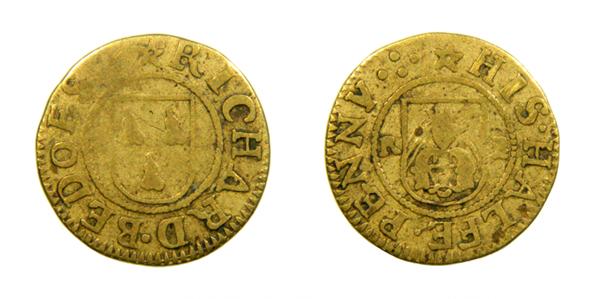About the Project

Undated halfpenny token of the Worcester mercer Richard Bedoes. Private collection.
The Worcestershire Token Project is an interdisciplinary research initiative exploring the seventeenth century token coinage of Worcestershire, a unique but neglected source of evidence for the economic, social, and cultural life of the county during the Civil War and its aftermath. Drawing together a vast body of numismatic, archaeological, and historical sources, the project seeks to advance knowledge of the county series through three key research areas:
1) Developing our numismatic understanding of the token series.
Since the publication of William Alfred Cotton’s 1885 study on The coins, tokens, and medals of Worcestershire there has been very little research into the county’s seventeenth century token coinage. Using modern numismatic methodologies, the project seeks to reassess Cotton’s work on the basis of a comprehensive die-study of surviving specimens in public and private collections, augmented by the evidence of archaeological finds and historical documents. In particular, the project seeks to amend and clarify Cotton’s classification of the Worcestershire series, with a particular focus on understanding the absolute and relative chronologies of token issuance and on clarifying aspects of token manufacture, including the identification of distinct token ‘workshops’.
2) Situating the token coinage in its economic context.
The role of tokens in the early modern economy is poorly understood, reflecting both a lack of historical evidence for the circulation of ‘small change’ and the underdeveloped character of quantitative archaeological and numismatic approaches within the field of token studies. The project seeks to improve this situation from three angles:
a) The application of die-estimation formulae to the token dataset, calibrated by documentary evidence, to establish the likely number of tokens produced for local circulation during the mid- to late seventeenth century;
b) The analysis of documentary sources and archaeological findspots of tokens to characterise patterns in token use;
c) The analysis of archaeological and documentary sources to understand the wider topography of coin and credit use in seventeenth century Worcestershire.
3) Understanding the people behind the tokens.
Worcestershire tokens record the names of hundreds of men and women – from bailiffs to booksellers, and from chandlers to clothiers. Applying biographic and prosopographic approaches to historical evidence relating to these individuals will allow us to build up a picture of the people behind the objects, and understand the social circles within which they – and the tokens they commissioned – lived and worked.
The project is constantly developing, and always seeks new information – if you collect Worcestershire tokens, know someone who does, or have any other contribution you’d like to make, don’t hesitate to get in touch!
Murray Andrews
